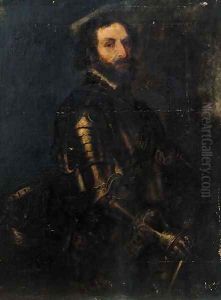Giacomo Robusti Called Tintoretto Paintings
Giacomo Robusti, famously known as Tintoretto due to his father's profession as a dyer (tintore in Italian), was a prolific Venetian painter and a notable figure of the Renaissance. Born in 1518 in Venice, Italy, Tintoretto was recognized for his phenomenal energy in painting which combined the rich colors typical of the Venetian school with the dramatic lighting and vigorous movement characteristic of the Mannerist style. His nickname, Tintoretto, literally means 'little dyer,' reflecting his family background.
Tintoretto's early years were marked by an intense apprenticeship. Though legend suggests he was briefly a pupil of Titian, their styles were markedly different, indicating that Tintoretto's training might have been more eclectic, drawing from various sources including, perhaps, the work of Michelangelo and the Mannerists. Tintoretto's work was distinguished by its dramatic use of perspective and special effects, notably in his rendering of light and shadow, which gave his paintings an extraordinary sense of motion and depth.
He was an extraordinarily fast painter, which, combined with his lower pricing, allowed him to secure numerous commissions across Venice. His major works include vast narrative cycles in the Scuola Grande di San Rocco and the Sala dell'Albergo, where his masterpieces, such as the 'Crucifixion' and 'The Miracle of the Slave,' demonstrate his ability to depict biblical and mythological scenes with intense emotion and dynamic compositions.
Tintoretto's contributions to Venetian art were not limited to religious and mythological scenes; he also excelled in portraiture, capturing the likenesses and personalities of his sitters with keen observation and psychological depth. Despite his success, Tintoretto remained an artist dedicated to his craft rather than to personal fame.
He died in 1594, leaving behind a legacy that would influence the Baroque artists of the 17th century. Tintoretto's work is characterized by its boldness and inventiveness, qualities that made him one of the most remarkable artists of the Renaissance and solidified his reputation in the annals of art history.
